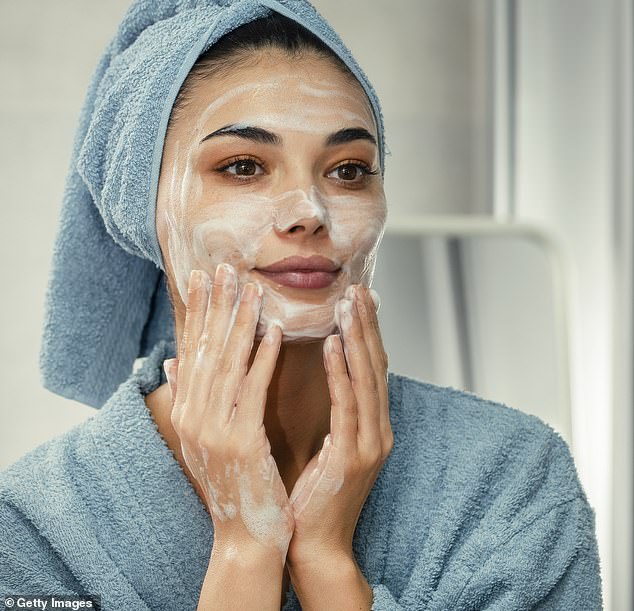Given the dizzying number of anti-aging skincare ranges out there, it’s pretty clear that there are a lot of us eager to discover the secret formula to youthful, flawless looking skin.
But dermatologists and cosmetic doctors warn that this quest for perfection can become an obsession. Experts are witnessing an alarming increase in middle-aged women affected by a new condition, “dermorexia.”
It is an obsession with using excessive amounts of skincare products and following an elaborate beauty routine. Ironically, applying too many products, many of them with harsh active ingredients, can cause or worsen skin conditions such as acne, eczema, dermatitis, rosacea and psoriasis.
“I’ve seen people spend over £2,000 a month on skincare products,” says Dr Penelope Tympandis, a consultant dermatologist in Harley Street. “On products they don’t need.”
Penelope Tympandis, a consultant dermatologist on Harley Street, says she has seen people spend more than £2,000 a month on skincare products.
Dermorexia was first detected among teenagers and young adults, when beauty influencers, also known as “Sephora Kids,” began sharing their 12-step skincare routines on TikTok. It is now widespread among middle-aged women seeking poreless, glowing skin to mimic the filters they use on social media.
Dermorexia comes in a variety of forms, with the skin conditions mentioned above being the most common. But Dr. Tympandis says typical cases can range from dull, over-clogged skin prone to blackheads and acne, to red, often scaly, and very sensitive skin.
The first is caused by overuse of nourishing anti-aging creams and rich moisturizers, and the second by overuse of products with high concentrations of glycolic acid, niacinamide, retinol, salicylic acid and AHAs (alpha hydroxy acids) that can cause inflammation and damage the skin.
A clear example is that of Tiffany, a 45-year-old lawyer from London, who was unknowingly suffering from ermorexia when she consulted Dr. Surbhi Virmani, a cosmetic dermatologist.
Often, dermorexics may have psychological problems, aggravated by low self-esteem, which leads them to consume many more products than they need.
One such case is Tiffany, a 45-year-old lawyer from London, who was unknowingly suffering from dermorexia when she consulted Dr. Surbhi Virmani, a cosmetic dermatologist.

Experts are witnessing an alarming increase in middle-aged women affected by a new disease, ‘dermorexia’
“Tiffany was ruining her complexion with harsh acids and too many exfoliants, leaving her skin irritated and sensitive. The condition had also affected her confidence. The good news is that we fixed it with the right skincare and a little patience.”
Dr Virmani recommends a simple three-step routine. ‘My favourite budget cleansers are from Byoma (£9.99, Boots.com). They are available in cream and gel formulas to suit individual needs and are fantastic for soothing sensitive skin. For moisturising, try a new Polish brand called ProXN (proxn.eu/home-en), contains a hops antioxidant that is powerful yet gentle, and helps strengthen and restore the skin barrier and prevent inflammation.
‘A good SPF is important all year round and Synchrorose Intensive SPF30 (£40, en.drmedispa.com) and Theraderm Platinum Protection (£30.99, en.theraderm.net) are excellent sunscreens for sensitive skin. I also recommend not cleansing in the morning when the skin barrier is already damaged, as this can irritate the problem.
Do you suffer from dermorexia?
1. Suddenly you suffer from sensitive or reactive skin.
New problems such as breakouts, redness and dermatitis are often attributed to overuse of products.
Overusing occlusive products (designed to retain moisture) can clog pores and lead to inflammatory acne. If you like to layer products, stick to noncomedogenic products that won’t disrupt skin function. Try brands like La Roche Posay, Cerave, Cetaphil, Neutrogena, Dermalogica and Eucerin.
2. You’re seeing several dermatologists, but you’re not satisfied. This is a “red flag,” says Dr. Wassim Taktouk
‘The dermatologists I have visited invariably tell me that the different doctors who treat them prescribe different products.’
3. You are obsessed with getting “glass skin”
Social media hashtags including “glass skin” or “dolphin skin” have been blamed for the rise in dermorexia. “These images are not realistic and usually show a person slathering their skin with oil and using a nice ring light,” says aesthetician Teresa Tarmey.
4. You have swollen eyes
“There are also small blood vessels around the orbital area that can temporarily dilate and swell with overuse of rich eye creams,” says Dr. Tympandis. “Gently apply a pea-sized amount of eye cream to the periorbital bone (the top of the cheekbone) and allow it to spread throughout the area rather than spreading it across the eyelids.”
5. You have cupboards full of unused products
Most conventional skincare products with stabilised active ingredients have an expiry date and lose effectiveness after two years, although “organic” ones can last just six months. “People are wasting their money and compromising the condition of their skin,” says Dr Emma Craythorne, who advocates three skincare steps in the morning (cleanser, moisturiser and sun protection) and two in the evening (cleanser and night treatment moisturiser).
6. You are forensically examining small changes in your face.
“It’s gone from patients with unrealistic expectations of what can be achieved with skin care to many who are convinced there is something physically wrong with their face,” says Dr. Taktouk.
‘A big part of my job now is reassuring patients that their skin looks perfectly normal and then helping them simplify their routines.’

